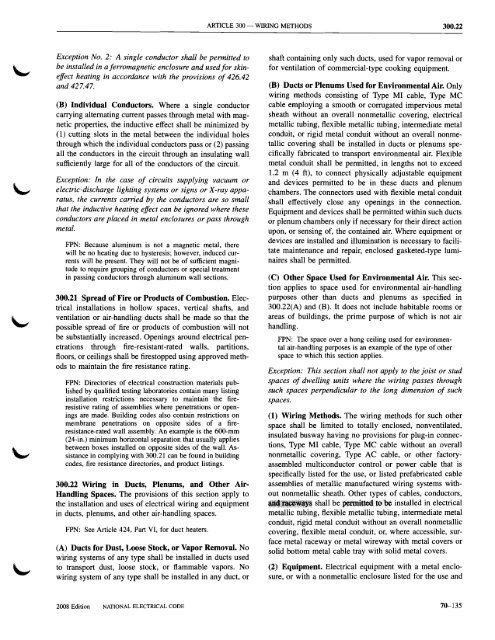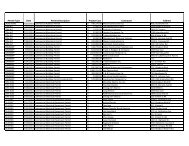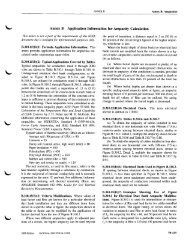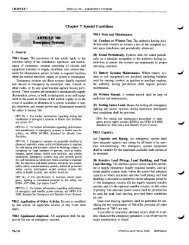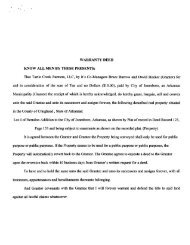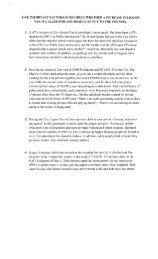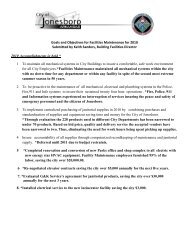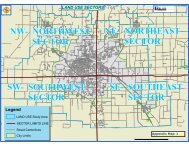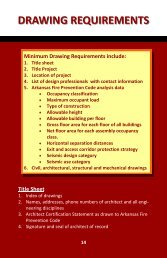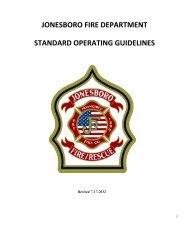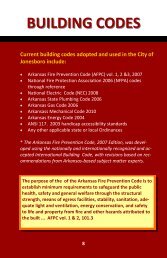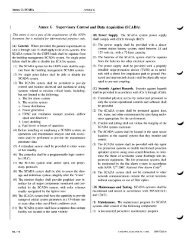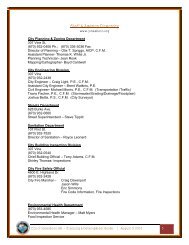Chapter 3 Wiring Methods and Materials
Chapter 3 Wiring Methods and Materials
Chapter 3 Wiring Methods and Materials
You also want an ePaper? Increase the reach of your titles
YUMPU automatically turns print PDFs into web optimized ePapers that Google loves.
ARTICLE 300 -<br />
WIRING METHODS<br />
300.22<br />
Exception No.2: A single conductor shall be permitted to<br />
be installed in a ferromagnetic enclosure <strong>and</strong> used for skineffect<br />
heating in accordance with the provisions of 426.42<br />
<strong>and</strong> 427.47.<br />
(B) Individual Conductors. Where a single conductor<br />
carrying alternating current passes through metal with magnetic<br />
properties, the inductive effect shall be minimized by<br />
(1) cutting slots in the metal between the individual holes<br />
through which the individual conductors pass or (2) passing<br />
all the conductors in the circuit through an insulating wall<br />
sufficiently large for all of the conductors of the circuit.<br />
Exception: In the case of circuits supplying vacuum or<br />
electric-discharge lighting systems or signs or X-ray apparatus,<br />
the currents carried by the conductors are so small<br />
that the inductive heating effect can be ignored where these<br />
conductors are placed in metal enclosures or pass through<br />
metal.<br />
FPN: Because aluminum is not a magnetic metal, there<br />
will be no heating due to hysteresis; however, induced currents<br />
will be present. They will not be of sufficient magnitude<br />
to require grouping of conductors or special treatment<br />
in passing conductors through aluminum wall sections.<br />
300.21 Spread of Fire or Products of Combustion. Electrical<br />
installations in hollow spaces, vertical shafts, <strong>and</strong><br />
ventilation or air-h<strong>and</strong>ling ducts shall be made so that the<br />
possible spread of fire or products of combustion will not<br />
be substantially increased. Openings around electrical penetrations<br />
through fire-resistant-rated walls, partitions,<br />
floors, or ceilings shall be firestopped using approved methods<br />
to maintain the fire resistance rating.<br />
FPN: Directories of electrical construction materials published<br />
by qualified testing laboratories contain many listing<br />
installation restrictions necessary to maintain the fireresistive<br />
rating of assemblies where penetrations or openings<br />
are made. Building codes also contain restrictions on<br />
membrane penetrations on opposite sides of a fireresistance-rated<br />
wall assembly. An example is the 600-mm<br />
(24-in.) minimum horizontal separation that usually applies<br />
between boxes installed on opposite sides of the wall. Assistance<br />
in complying with 300.21 can be found in building<br />
codes, fire resistance directories, <strong>and</strong> product listings.<br />
300.22 <strong>Wiring</strong> in Ducts, Plenums, <strong>and</strong> Other Air<br />
H<strong>and</strong>ling Spaces. The provisions of this section apply to<br />
the installation <strong>and</strong> uses of electrical wiring <strong>and</strong> equipment<br />
in ducts, plenums, <strong>and</strong> other air-h<strong>and</strong>ling spaces.<br />
FPN: See Article 424, Part VI, for duct heaters.<br />
(A) Ducts for Dust, Loose Stock, or Vapor Removal. No<br />
wiring systems of any type shall be installed in ducts used<br />
to transport dust, loose stock, or flammable vapors. No<br />
wiring system of any type shall be installed in any duct, or<br />
shaft containing only such ducts, used for vapor removal or<br />
for ventilation of commercial-type cooking equipment.<br />
(B) Ducts or Plenums Used for Environmental Air. Only<br />
wiring methods consisting of Type MI cable, Type Me<br />
cable employing a smooth or corrugated impervious metal<br />
sheath without an overall nonmetallic covering, electrical<br />
metallic tubing, flexible metallic tubing, intermediate metal<br />
conduit, or rigid metal conduit without an overall nonmetallic<br />
covering shall be installed in ducts or plenums specifically<br />
fabricated to transport environmental air. Flexible<br />
metal conduit shall be permitted, in lengths not to exceed<br />
1.2 m (4 ft), to connect physically adjustable equipment<br />
<strong>and</strong> devices permitted to be in these ducts <strong>and</strong> plenum<br />
chambers. The connectors used with flexible metal conduit<br />
shall effectively close any openings in the connection.<br />
Equipment <strong>and</strong> devices shall be permitted within such ducts<br />
or plenum chambers only if necessary for their direct action<br />
upon, or sensing of, the contained air. Where equipment or<br />
devices are installed <strong>and</strong> illumination is necessary to facilitate<br />
maintenance <strong>and</strong> repair, enclosed gasketed-type luminaires<br />
shall be permitted.<br />
(C) Other Space Used for Environmental Air. This section<br />
applies to space used for environmental air-h<strong>and</strong>ling<br />
purposes other than ducts <strong>and</strong> plenums as specified in<br />
300.22(A) <strong>and</strong> (B). It does not include habitable rooms or<br />
areas of buildings, the prime purpose of which is not air<br />
h<strong>and</strong>ling.<br />
FPN: The space over a hung ceiling used for environmental<br />
air-h<strong>and</strong>ling purposes is an example of the type of other<br />
space to which this section applies.<br />
Exception: This section shall not apply to the joist or stud<br />
spaces of dwelling units where the wiring passes through<br />
such spaces perpendicular to the long dimension of such<br />
spaces.<br />
(1) <strong>Wiring</strong> <strong>Methods</strong>. The wiring methods for such other<br />
space shall be limited to totally enclosed, nonventilated,<br />
insulated busway having no provisions for plug-in connections,<br />
Type MI cable, Type MC cable without an overall<br />
nonmetallic covering, Type AC cable, or other factoryassembled<br />
multiconductor control or power cable that is<br />
specifically listed for the use, or listed prefabricated cable<br />
assemblies of metallic manufactured wiring systems without<br />
nonmetallic sheath. Other types of cables, conductors,<br />
.Ilil.l.~~ shall be ~ttei,ltol,,¢ installed in electrical<br />
metallic tubing, flexible metallic tubing, intermediate metal<br />
conduit, rigid metal conduit without an overall nonmetallic<br />
covering, flexible metal conduit, or, where accessible, surface<br />
metal raceway or metal wireway with metal covers or<br />
solid bottom metal cable tray with solid metal covers.<br />
(2) Equipment. Electrical equipment with a metal enclosure,<br />
or with a nonmetallic enclosure listed for the use <strong>and</strong><br />
2008 Edition NATIONAL ELECTRICAL CODE<br />
70-135


